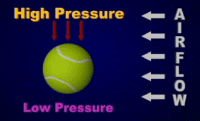Fun With Bernoulli

Activity courtesy of TeachEngineering.org, a searchable online library of standards-based, engineering lessons and activities compiled by the College of Engineering’s Integrated Teaching and Learning Program at the University of Colorado, Boulder.
Summary
Students in grades 5 to 7 use Bernoulli’s principle to manipulate air pressure in a series of fun activities so its influence can be seen on the objects around us.
Grade level: 5-7
Time: 35 minutes
Cost: 50 cents per student
Engineering Connection
- Explain that air pressure decreases as the speed of air increases.
- Explain that air pressure acts in all directions (not just down).
- Explain that engineers use their understanding of pressure differences to make airplanes fly.
Standards
Common Core State Mathematics Standards
Write, read, and evaluate expressions in which letters stand for numbers. [Grade 6]
Next Generation Science Standards
Plan an investigation to provide evidence that the change in an object’s motion depends on the sum of the forces on the object and the mass of the object. [Grades 6 – 8]
International Technology and Engineering Educators Association: Technology
Knowledge gained from other fields of study has a direct effect on the development of technological products and systems. [Grades 6 – 8]
- 1 sheet of paper (new or recycled)
- 2 round balloons
- 2 pieces of string (18 inches long)
- 2 small plastic cups
- 2 straws
- 1 ping pong ball
- water
- Fun with Bernoullil Worksheet
Introduction/Motivation

Why does a curve ball curve? Why does an airplane fly? The reasons can be found in Bernoulli’s principle, which states that the faster a fluid moves the less pressure it exerts. Different air velocities are present on different parts of a curveball as well as on the different parts of an airplane. Bernoulli’s principle tells us that these differences in velocity mean differences in pressure exist as well. On a curveball, the difference in pressure causes the ball to move sideways. Engineers use their understanding of pressure differences to make airplanes fly.
(Image from NASA article on moon golf.)
Procedure
Before the Activity
With the Students
Part A: The Paper Tent
- Have students fold a piece of paper (lengthwise) in half and make a paper tent.
- Ask students to predict what will happen when they blow into the tent. Will it appear to get larger, will it remain unchanged, or will it bend down toward the table? (Alternately, have students turn their paper tents upside down and blow through the V-shaped paper.)
- Make sure students notice that the tent flattens.This is because the air moving through the inverted V has less pressure, so the higher pressure on the outside of the paper tent flattens the paper.
- Have students experiment with their paper tents, answer the relevant worksheet questions, and discuss their results.
Part B: Moving Balloons
- Blow up two balloons. Tie them off, and then attach a string to each one.
- Have students hold the two balloons together.
- Ask them to predict what will happen when they blow between the two balloons. Have students record their hypotheses in the space provided on the worksheet.
- Have students hold the balloons 4-6 inches apart and blow between them. If they hold the balloons too close together, the balloons simply move away from the student. The balloons must be sufficiently far apart so that students can blow betweenthe balloons, not at the balloons.
- Expect students to see the balloons come together just like the paper V in Part A of the Procedures section.
- Have students complete the worksheet and discuss the results.
Part C: Magic Moving Ball
- Place two plastic cups about 6 inches apart.
- Place a ping pong ball in one of the cups.
- Ask the students to predict how to get the ball from one cup to the other without touching either the ball or cup.
- Have the students try a few of their ideas.
- Tell the students to gently blow across the top of the cup with the ball in it.
- The ball should jump from one cup to the next. This is because the air pressure moving across the top of the cup is less than the pressure inside the cup. The higher pressure inside the cup forces the ping pong ball to jump out of the cup.
- Have the students experiment with how far apart they can place the cups and still get the ping pong ball to jump from one to the other.
Part D: Bernoulli’s Water Gun
- Give the students one cup filled with water and two straws.
- Have students place one of the straws in the water.
- Then, have students cut the second straw in half to use as a “blower.”
- Ask the students to predict what will happen if they blow across the top of one straw in the water with the other straw.
- Have students blow across the top of the straw with the other straw.
- Expect the water to rise up in the first straw and blow across the table. This happens because the air blowing across the straw in the cup reduces the air pressure at that point. The normal pressure underneath pulls the water up the straw and the moving air blows the water out and across the room.
- Have students experiment with different straw lengths as the “blower.”
Attachments
Troubleshooting Tips
- In advance, cut the string pieces to speed up the activity.
- Have a plan for the balloons after the activity is complete; otherwise, leaving the balloons with the students quickly becomes a distraction.
Assessment
Pre-Activity Assessment
- Review with students the Bernoulli principle. Make sure everyone understands the concept. (The faster a fluid moves the less pressure it exerts.)
Activity Embedded Assessment
Post-Activity Assessment
- Given what we have learned, how does the Bernoulli principle relate to airplane flight? (Answer: If air moves faster on one side of an object, the air pressure decreases and the object will move in the direction of the faster moving air. This is how wings create lift and why the objects in this experiment move in the direction of the faster air.)
Activity Extensions
- Have students search for “Bernoulli principle” on the Internet to find an online demonstration of how the Bernoulli principle works.
- Have students blow with a straw between two empty soda cans laying on their sides. Expect the cans to roll together just like the balloons came together. Will this will work with any two objects? Have students investigate and write a paragraph summarizing their findings. (Answer: Most objects will do this unless the objects are too heavy to blow apart.)
Additional resources
- Bernoulli’s Principle. NASA lessons, hands-on activities, and history of 18th-century scientist Daniel Bernoulli for student in grades 5 to 8. [PDF]
- Video: Bernoulli’s Principle. Physics is Fun demo with ping pong ball and running tap water. YouTube: 1:14]
- Lift: Bernoulli’s Principle. Smithsonian Air & Space Museum video from How Things Fly series.
Contributed by Tom Rutkowski, Alex Conner, Geoffrey Hill, Malinda Schaefer Zarske, Janet Yowell © 2004 by Regents of the University of Colorado. Supported by the Integrated Teaching and Learning Program, College of Engineering, University of Colorado Boulder.
Filed under: Class Activities, Grades 6-8, Grades 6-8, Grades K-5, Grades K-5, Lesson Plans
Tags: Aerodynamics, Aeronautics, Automotive engineering, Bernoulli's principle, Class Activities, forces and motion, Grades 6-8, Grades K-5, Lesson Plans, Mathematics, Physics








